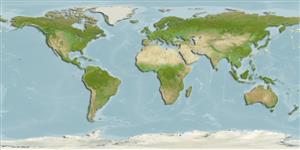Myxini (Kieferlose) (hagfishes) >
Myxiniformes (Hagfishes) >
Myxinidae (Hagfishes) > Myxininae
Etymology: Myxine: Ancient Greek word for a slimy fish: myxa, slime; -inus, one who, referring to copious amounts of slime produced by M. glutinosa (See ETYFish); formosana: Formosan, referring to Formosa, historical name of Taiwan, type locality (See ETYFish).
Environment: milieu / climate zone / depth range / distribution range
Ökologie
seewasser bathydemersal; standorttreu; tiefenbereich 588 - 1500 m (Ref. 40969). Deep-water
Western Pacific: Taiwan (Ref. 40969) and possibly in the Philippines (Ref. 95645).
Size / Gewicht / Alter
Maturity: Lm ? range ? - ? cm
Max length : 76.8 cm TL Männchen/unbestimmt; (Ref. 40969)
Kurzbeschreibung
Bestimmungsschlüssel | Morphologie | Morphometrie
Head white; body and tail grayish-black to dark purple. A 3-cusp multicusp on the anterior set of cusps and 2-cusp multicusp on the posterior set. Gill pouches, generally 5 pairs (rarely 4). Slime pores 0 - 4 (mostly 2) above the area between the anterior and posterior ends of the cloaca. Anterior unicusps 10 (8-12) on each side. Anterior part of ventral finfold (VFF) higher than posterior part (mostly vestigial). Caudal finfold (CFF) low to vestigial (Ref. 40969).
Caught using shrimp traps (Ref. 40969).
Life cycle and mating behavior
Geschlechtsreife | Fortpflanzung | Ablaichen | Eier | Fecundity | Larven
Copulatory organ absent. The gonads of hagfishes are situated in the peritoneal cavity. The ovary is found in the anterior portion of the gonad, and the testis is found in the posterior part. The animal becomes female if the cranial part of the gonad develops or male if the caudal part undergoes differentiation. If none develops, then the animal becomes sterile. If both anterior and posterior parts develop, then the animal becomes a functional hermaphrodite. However, hermaphroditism being characterised as functional needs to be validated by more reproduction studies (Ref. 51361 ).
Mok, H.-K. and C.-H. Kuo, 2001. Myxine formosana, a new species of hagfish (Myxiniformes: Myxinidae) from southwestern waters of Taiwan. Ichthyol. Res. 48(3):295-297. (Ref. 40969)
IUCN Rote Liste Status (Ref. 130435: Version 2024-1)
Bedrohung für Menschen
Harmless
Nutzung durch Menschen
Tools
Zusatzinformationen
Download XML
Internet Quellen
Estimates based on models
Preferred temperature (Ref.
123201): 3.8 - 6.5, mean 5.5 °C (based on 45 cells).
Phylogenetic diversity index (Ref.
82804): PD
50 = 0.5000 [Uniqueness, from 0.5 = low to 2.0 = high].
Bayesian length-weight: a=0.00115 (0.00044 - 0.00298), b=3.03 (2.80 - 3.26), in cm total length, based on LWR estimates for this (Sub)family-body shape (Ref.
93245).
Trophic level (Ref.
69278): 3.4 ±0.6 se; based on size and trophs of closest relatives
Widerstandsfähigkeit (Ref.
120179): niedrig, Verdopplung der Population dauert 4,5 - 14 Jahre. (Fec assumed to be <100).
Fishing Vulnerability (Ref.
59153): Moderate to high vulnerability (51 of 100).
